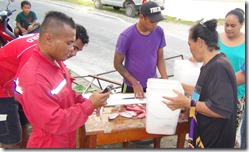
The Coastal Team of the Tuvalu Fisheries Department (TFD) and local data collectors from eight islands of Tuvalu have found that overfishing is now a major issue for Tuvalu inshore fishes. The Coastal Team’s survey data, shows that inshore fisheries throughout Tuvalu are showing stress.
According to the TFD Creel Survey Report No. 2 there were a total of 39,263 specimens measured during the survey (2015-2018), including 268 inshore species of fishes in 106 families and 134 genera, and a total of 42.13 tones of catches measured. The results show that 39% of species were being landed with 50% or more of the fish undersized; that is, smaller than their known size at which they can reproduce. This shows that there is a pressure on the coastal reef fish resources on all islands surveyed.
The TFD currently play a role in Funafuti, in partnership with the Kaupule, fishers and communities in managing this issue through implementing Funafuti Reef Fishery Stewardship Plan (FRFSP). Among the FRFSP priorities is to strengthen the Funafuti Conservation Area (FCA), establisg size limits for fishes and encourage the diverion of fishing effort more offshore to tuna and other pelagic species. This is the second creel report the Coastal section has prepared since the first creel report TFD Creel Survey Report, 1 was published in 2016.
The analysis of creel survey data is a regular part of the Coastal Fisheries Section work. This work is being done to provide anonymous information on the fishers, data on the resources being caught and the effort required in a way that can be used to assess the health of the inshore fishery. One of the main aspects of the creel survey is to identify stressed resources in need of management.
the Coastal Section of TFD has been undertaking its creel survey since April 2015 and the work is on-going on all islands of Tuvalu except for Niulakita. Monitoring over time will provide feedback to management actions by providing a trace of percent of the catch below size at maturity over time. If management is successful in improving the state of the resources, we should see the percentage of undersized reef fishes decline. Overall productivity is expected to increase when the breeding population is improved.
Outer Island Data Collectors (OIDCs) and the Coastal Survey Team have been meeting fishers at their landing sites to interview them and collect data on the methods and gear they are using for fishing. Fishing locations and their perceptions on the fishery and changes over time are also collected. At the same time, the team measure and weigh each specimen in the catch. All data are then entered into a database from which the coastal team can access results to assess the resources.
Collecting data is an on-going task with data collectors from all Tuvalu islands providing much of the data on fish identifications and filling in details on all parts of the survey sheet. The Coastal Team conduct awareness programmes and consultations with communities on the results of the surveys and the implementation of the Funafuti Reef Fisheries Stewardship Plan. Fishery management are also being developed with the Kaupules and communities on all the outer islands of Tuvalu
